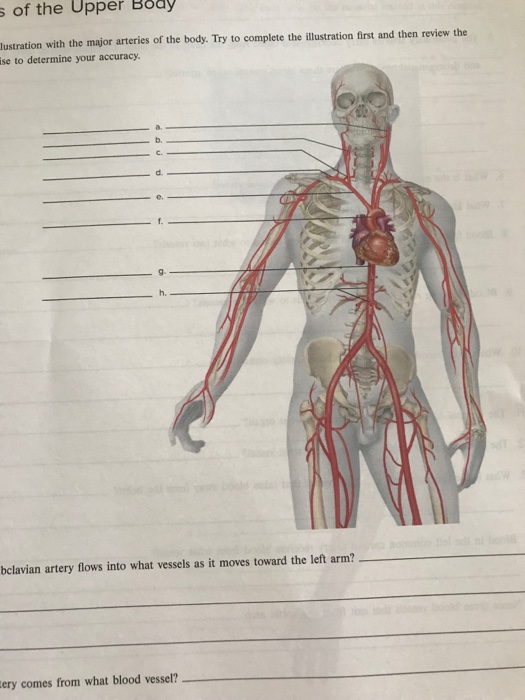What Are The Major Blood Vessels In The Body | Blood vessels are key components of the systemic and pulmonary circulatory systems that distribute blood throughout the body. Arteries that carry blood away from the heart, branching into smaller arterioles throughout the body and eventually forming the. Veins are the major vessels of the venous system. An extraordinary degree of branching of blood vessels exists within the human body, which ensures that nearly every cell in the body lies within a short distance from at least one of. There are three major types of blood vessels:
These vessels transport blood cells, nutrients, and oxygen to the tissues of the body. Transportation of materials, protection from pathogens, and regulation of the body's homeostasis. Arteries carry blood away from the heart. They also take waste and carbon dioxide away from the tissues. There are three major types of blood vessels:
:background_color(FFFFFF):format(jpeg)/images/library/11145/arteries-of-the-head-lateral-view_english.jpg)
The cardiovascular system has three major functions: Blood vessels are often named after either the region of the body through. Vein is a blood vessel carrying blood to the heart. Contents what are the 5 major blood vessels? The average diameter is eight micrometers with a very thin wall of 0.2 micrometers. Describes arteries, veins, and capillaries, and distinguishes between the pulmonary the major arteries of the neck are shown here in red. The left ventricle of the heart pumps oxygenated blood into the aorta. There are three major types of blood vessels: An extraordinary degree of branching of blood vessels exists within the human body, which ensures that nearly every cell in the body lies within a short distance from at least one of. From here, it is pumped into the systemic circulatory system through a larger, elastic artery. Blood is pumped away from the heart at high pressure in arteries, and returns to the heart at low pressure in veins. Blood vessels flow blood throughout the body. The blood vessels are the components of the circulatory system that transport blood throughout the human body.
How well do you know the anatomy here? Ventricular walls are thicker than atrial walls because the ventricles have to pump blood further. The average diameter is eight micrometers with a very thin wall of 0.2 micrometers. The capillaries, which enable the actual exchange of water and chemicals between the blood and the. The body has approximately 100,000 km.

The major (or great) blood vessels of the heart are the larger arteres and veins that attach to the atria and ventricles and transport blood to and from the blood passes from the left atrium into the left ventricle. Let's have a look.daily anatomy app:for a random. The left ventricle of the heart pumps oxygenated blood into the aorta. Ventricular walls are thicker than atrial walls because the ventricles have to pump blood further. The dorsal blood vessels carry blood to the front of the earthworm's body whereas the ventral blood vessels are responsible for carrying blood to the rear of the earthworm's body. The capillaries, which enable the actual exchange of water and chemicals between the. When the heart contracts, blood is pumped into arteries exposure to tobacco smoke causes immediate damage not only to the lungs, but also to blood vessels throughout the body. The arteries, which carry the blood away from the heart; The blood vessels are the part of the circulatory system that transports blood throughout the human body. The carotid system of arteries and the jugular system of veins. There are three major types of blood vessels: The average diameter is eight micrometers with a very thin wall of 0.2 micrometers. There are three major types of blood vessels:
There are three major types of blood vessels: Blood is pumped from the ventricles into large elastic arteries. This blood is carried by several different types of blood vessels, each of which are specialised to play their role in circulating blood around the body. The walls of the capillaries are only 1 cell thick, and this allows for the exchange of nutrients and other substances like oxygen and carbon dioxide between cells and the bloodstream. The largest blood vessel in the human body is the aorta, which is located to the left of the heart.

The dorsal blood vessels carry blood to the front of the earthworm's body whereas the ventral blood vessels are responsible for carrying blood to the rear of the earthworm's body. The walls of the capillaries are only 1 cell thick, and this allows for the exchange of nutrients and other substances like oxygen and carbon dioxide between cells and the bloodstream. Capillary is a tiny vessel which connects the smallest arteries and veins. When the heart contracts, blood is pumped into arteries exposure to tobacco smoke causes immediate damage not only to the lungs, but also to blood vessels throughout the body. Blood vessels are the channels or conduits through which blood is distributed to body tissues. Blood is pumped from the ventricles into large elastic arteries. The heart pumps blood through big blood vessels called arteries and veins. There are three major types of blood vessels: Blood vessels flow blood throughout the body. Below the thoracic artery are the intercostal arteries, which supply blood to the ribs, and the celiac artery. Arteries that carry blood away from the heart, branching into smaller arterioles throughout the body and eventually forming the. Figures 1 and 2 show the major arteries and veins of the body. Arteries, which carry oxygen and nutrients to the body.
What Are The Major Blood Vessels In The Body: Veins return blood back toward the heart.
Refference: What Are The Major Blood Vessels In The Body
comment 0 komentar
more_vert